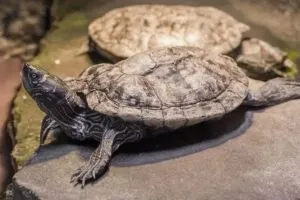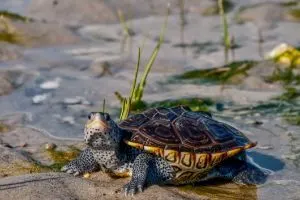Terrapins are actually turtles, and while they do not belong to a distinct species, all terrapins are turtles. In fact, some use the term terrapin to simply refer to freshwater turtles.
Terrapins are endemic to brackish and freshwater habitats and are generally small to average in size. Due to their size, terrapins are generally kept as pets.
Some popular terrapins include the Diamondback terrapin (which is simply called terrapin), the red-eared slider (also known as the red-eared terrapin), the Cumberland slider (also known as the Cumberland terrapin), and the yellow-bellied slider (also known as the yellow-bellied terrapin). In all, there are about 14 turtle species that are referred to as terrapins.
In this article, we will take a look at what terrapins are and also learn how to care for one.
What are terrapins?
Difference Between Terrapins And Turtles

The term terrapin is specifically and originally used for the turtle Diamondback terrapin. This turtle is generally known as just ‘terrapin’. As such, we will be focusing mainly on this turtle in this article.
Different chelonians go by several different names such as cooters, sliders, turtles, terrapins, and tortoises. Knowing which is which can be a little confusing for a novice. Hopefully, I can clear up any confusion, today.
Scientifically, turtle refers to all species in order Chelonia. As such, all chelonians are turtles. This includes sea turtles, freshwater turtles, tortoises, cooters, sliders, and all the rest. As such, by this definition, terrapins are turtles.
However, most people including experts and even herp vets refer to sea turtles & freshwater turtles as turtles, excluding tortoises.
So, that leads us back to the question “are terrapins turtles?” and what do they fall under?
Well, terrapins are actually freshwater turtles as opposed to sea turtles. Just like sliders and cooters, terrapins are freshwater turtles.
There is no scientific classification that places all terrapins under one umbrella, unlike sliders (who all belong to a single genus – Trachemys) & cooters (who all belong to a single genus – Pseudemys).
To put in scientific terms, terrapins don’t form a taxonomic unit.
Here is a list of all turtles that are have been referred to as terrapins:
- Diamondback terrapin, also known as just “terrapin”, (Malaclemys terrapin)
- Red-eared terrapin, (Trachemys scripta elegans)
- Yellow-bellied terrapin, also known as Yellow-bellied slider, (Trachemys scripta scripta)
- Striped-neck terrapin also known as Caspian turtle, (Mauremys caspica)
- Smiling terrapin, also known as black marsh turtle, (Siebenrockiella crassicollis)
- Seychelles black terrapin, (Pelusios seychellensis) – currently considered extinct
- Serrated hinged terrapin, (Pelusios sinuatus)
- Painted terrapin, (Batagur borneoensis)
- Northern river terrapin, (Batagur baska)
- Southern river terrapin, (Batagur affinis)
- Mexican spotted terrapin also known as Mexican spotted wood turtle, (Rhinoclemmys rubida)
- Indian pond terrapin, also known as Indian black turtle, (Melanochelys trijuga)
- European pond terrapin, also known as European pond turtle, (Emys orbicularis)
- Bengal eyed terrapin, also known as Burmese eyed turtle or Burmese peacock turtle, (Morenia ocellata)
Caring for terrapins
You need to set up the terrapin’s enclosure two weeks before you introduce the terrapin to it. This is to ensure that everything is running properly. The water temperature needs to be right and the filter should be working properly.
The enclosure must also have the basking platform installed. When you first introduce the terrapin to the enclosure, the lights should be off until the next day.
Terrapin Enclosure

Among freshwater turtles, terrapins are quite large. As such, they require large enclosures. Just how large can a terrapin grow up to?
Well, terrapins can grow up to 9 inches (23 cm) which is quite large. Your terrapin may be small now, but it won’t stay that way forever. To ensure your terrapin is covered, house it in a fairly large enclosure.
Anywhere between 60 gallons to 100 gallons should be large enough. In fact, it’s best to go for a 100-gallon enclosure but a 75-gallon tank will do. You want the turtle to have enough space to swim and dive in as well as to be able to turn over if it is upside down.
Depending on the terrapin you have, you may need to fill the enclosure with brackish water. Some quality marine salt can be used to achieve this. The depth of the water should be about 3 times the length of the turtle’s shell.
The enclosure needs a basking area. This is a platform that sticks out of the water like an island. Over this basking platform, you need a basking lamp.
Of course, the water in the enclosure needs to be filtered continuously.
Lastly the pH level of the water should be between 6.8 and 7.0. You can use a water conditioner such as API TAP Water Conditioner to ensure that the pH level is within the right range, but you should double check using a test kit as well.
Substrate

There is a lot to choose from when it comes to substrates. Crushed coral is a suitable substrate, and is also a great source of calcium. Another substrate choice is river pebbles. These pebbles need to be large in size so the turtle doesn’t swallow them.
Temperature
Getting the temperature right is important. The temperatures required aren’t that hard to obtain. I advise that the water temperature never falls below 70 F. A temperature between 75 and 79 F is optimal.
If you must you can use a submersible aquarium heater to keep the temperature within the right range. A good options is the Orlushy Submersible Aquarium Heater paired with the BN-Link thermostat which will ensure you don’t overheat the water.
The basking area should have a temperature between 85 F and 95 F. This should keep the turtle warm and healthy.
You can do a setup with either a heat bulb that also provides UVB or you can use a ceramic heater and add a UVB bulb separately.
Lighting
The Zoo Med Basking bulb provides both lighting and heating.
However, ceramic heat lamps are advantageous since they can be on throughout the entire 24-hour day and controlled with either external or built in thermostats.
You should provide the turtle with 10-12 hours of UV exposure each day. and turn off the nights at night. UV lamps need to be changed roughly every 6 months as they lose intensity.
You can use a test card to check if they are still good. The lamp may look ok but they will produce less UV as time passes. It’s better to change them since a lack of UVB is a contributor to metabolic bone disease.
Feeding the Terrapin
Terrapins are omnivorous and must be fed a varied diet. This diet should include vegetation, vegetables and proteins. Quality commercial turtle food like Tetra ReptoMin Floating Food Sticks can also be offered.
Some animal-based foods to include in the turtle’s diet are frozen crayfish, shrimp, and even feeder fish. Freeze-dried krill and shrimp also work well.
You can also offer them aquatic plants. Just make sure these plants are edible. Some examples are water hyacinth, duckweed, arrowhead, waterweed, and pondweed.
For turtles kept indoors, supplements may not be an option but rather a must. You need to speak with your herp vet before giving supplements.
A high-quality supplement is Rep-Cal Calcium Powder with Vitamin D3 (Phosphorous-Free). Turtles kept indoors usually lack calcium and vitamin D3 and such supplements help address this issue.
Overfeeding can easily lead to a fat turtle or fat tortoise and unnatural growth. Feed juveniles and hatchlings once a day and adults every other day.
Terrapin’s Temperament & Handling
Terrapins hate to be handled. Frequent handling may be terrifying for your terrapin since they most likely assume you’re a predator. If you do handle yours you may find them being aggressive.
Timid and shy turtles can bite when handled. A new turtle will be extremely wary of you. It takes time for the turtle to warm up to you.
As the turtle gets acquainted with your presence, it will eventually allow you to pick it up without snapping at you. In all, terrapins prefer solitude.
Common Health Concerns
A healthy terrapin has a smooth shell with no cuts or bruises, bright and clear eyes, and an absence of any oozing. Registering with a qualified herp vet ensures your turtle has constant access to health care.
Intestinal parasites
The main symptom of internal parasites is lack of appetite. If the turtle isn’t eating as it normally does, then it may have parasites.
The turtle needs to be dewormed if it has intestinal parasites. You must see a qualified herp vet if you wish to address the problem.
Metabolic Bone Disease
MBD isn’t exactly a singular disease. Rather it refers to a wide variety of nutritional diseases and imbalances. Nutritional MBD is caused by calcium deficiency or vitamin D3 deficiency.
Symptoms of MBD include uneven shell, soft rubbery shells, swellings around the eyes and mouth. To prevent nutritional MBD, feed your turtle a well-balanced diet, expose the turtle to UV light, and supplement the turtle’s diet if needed.
Eye problems
Eye problems are usually linked to the water quality of the turtle’s enclosure. Ensure that the water in the enclosure is properly filtered and changed on a regular basis (at least once a week).
Vitamin A deficiency can also lead to eye problems. Feed the turtle vegetables high in beta carotenes such as shredded carrots or sweet potato.
Other common health concerns include shell rot, mouth infection, respiratory problems, and injuries.
Availability
When it comes to turtles, captive-bred are best. It’s advisable to avoid keeping wild turtles. It is bad for their wild populations. This includes terrapins.
The diamondback terrapin is quite an expensive turtle to acquire. A captive-bred terrapin can be acquired from reputable breeders, at reptile trade shows and expos. You can also contact reputable breeders through online sites such as Morph Market.
A captive-bred baby terrapin will cost you around $400.
Conservation/Threats
The diamondback terrapin has an IUCN Red List status of Vulnerable. So although the terrapin isn’t endangered, the wild population keeps falling.
Threats to terrapins include road mortality, commercial use of crab pots which trap terrapins as well, and habitat loss which is caused by residential and commercial development, as well as energy production and mining.
Conclusion
Many turtles are referred to as terrapins. However, the term terrapin applies mainly to sliders and diamondback terrapins. Terrapins make excellent pets. These turtles thrive in freshwater and brackish water.
Due to their moderate size and intricate patterns on their shells, terrapins are commonly kept as pets. As terrapins are types of freshwater turtle, their care is similar to that of other aquatic turtles.
Terrapins are also omnivores and as such accept a wide range of foods. The diamondback terrapins, in particular, need saltwater aquariums to thrive. If the turtle faces difficulties and health issues in a freshwater aquarium, it may be a good idea to switch to saltwater.
If you have any extra information or questions on terrapins, leave a comment below.
